Amber Seger. Graphic Designer. Master Student of Instructional Design and Technology. Striving for consistency, order, and clarity.
Don't wanna be here? Send us removal request.
Text
Final Project
How has each course contributed to your personal and professional development as an instructional designer?
Let me start out by saying, I have absolutely no regrets about choosing to go through this program. I have thoroughly enjoyed every class I’ve taken and found them to be incredibly insightful and useful. I feel like I have grown immensely personally and professionally. This branch of cognitive science resonates with me on a deeply profound level.
I’ve always been interested in how and why we interact with each other, products, and information. I’m a graphic designer by education and trade and my career has lead me down the path of higher information design and instruction. I love explaining concepts and training people how to perform tasks. I’m always eager to show people how to accomplish something if they do not know how to execute the intended outcome. This program has satisfied that intrinsic drive.
I loved that the Mastery: Personal Development and Leadership class was first. Instead of throwing you into the program headfirst. It was a great way to lay the foundation of my journey. I enjoyed making goals and researching about the masters in my field. Learning about the traits and paths that can lead to being a master changed my perspective on how and what I can achieve.
The timing of the Strategies for Learner Engagement and Visual and Visual and Verbal Communication in Instructional Design class occurred lined up perfectly with a presentation I gave for a work conference. I was able to utilize a lot of what I learned in that class and apply it to the content of my presentation about better information design.
Corporate Training and Motivational Development and Instructional Design and Evaluation were classes that really made me think about my writing and processes. Learning how and what motivates people will be greatly beneficial as I start to innovate the projects I create at work. The learning theories and models of instructional design will help me develop and evaluate the types of designs I want to create and implement at my job.
These four classes: Digital Media and Learning Applications, Music and Audio for Instructional Design, Filmmaking Principles for Instructional Design, and Game Strategies and Motivation, were super fun for me. I got to use a lot of my current skills as a graphic designer to leverage my projects. I got used to hearing my voice and watching myself on screen in these classes. That is hugely beneficial for my personal development. I used to be a very self conscious about how I sound and look. Now I feel very confident in my ability to perform. I was very happy to learn about audio design and filmmaking. I can also use what I learned outside of my actual career and into my hobby that is sort of turning into a side career. I record podcasts and stream games and now I can better use those tools.
Learning Management Systems and Organization was a class that I felt I didn’t really benefit from strongly. I was the only one in the class and I didn’t get a lot of interaction. I feel like if I had at least another student it would have been more engaging. I understand the basic concept of an LMS but didn’t really get to fully test it out. I honestly thought that this last and final class would utilize all the assets I created in the Media Asset Creation class and put them into an LMS.
Overall, I’ve enjoyed everything. Looking back, I have so many projects I can easily upload and put on to my portfolio and Behance. As fun, interesting, and fulfilling this program has been, I am so glad I’ve come to the end of the journey. The past year has been the most stressful and tiring year I have had in a long time. I’m so glad I persevered and have come out incredibly successful.
How well were you able to utilize the concepts and techniques you learned from the program (theories, systems design, interface styling, and the creation of multimedia content) as you designed, developed, and implemented your Final Project?
Well I’m not sure what the Final Project was exactly. As I said previously, I thought I would have taken assets I made in the last class and to create and design a course in an LMS. It would have been complete with tests and discussion board prompts much like the ones we have on FSO. All I had to do for this class was make portfolios using pre-built templates and interfaces. I did try to write an engaging About Me section so it would give a sense of personality.
Other than that, all of my projects I uploaded were created using techniques and theories I learned through out the class. The number one theory that I have retained is the cognitive load theory. That one to me is the most important out of everything, because if a learner experiences mental overload they tend to give up or become distracted. Everything I design going forward will be all about reducing cognitive load. I want to strive for clarity, order, and consistency.
Describe your most outstanding personal triumph in each course.
Mastery: Personal Development and Leadership
I was really happy with the visual design and layout of the timeline we created for this class. I also loved learning about Robert Gagne and all that he did for the field of instructional design. The paper I wrote about him was very good.
Strategies for Learner Engagement
I learned how to make interactive PDFs! I took a basic Lynda.com tutorial about making an infographic and was able to visually redesign it to make it more in line with how I would create it from scratch while still maintaining the overall theme of the infographic. I did a lot of research and writing about WWI artists and pushed myself to write in a more engaging storytelling style. I was very proud of that project and it is in my portfolio.
Visual and Verbal Communication in Instructional Design
I learned how to use Keynote! I had never used it before. I also had time and was able to make the graphics more in line with my style of design. I remember recording my first bit of narration for the class and when I listened to other student’s narration I felt very unskilled at engaging writing. I am a technical writer and copy editor and I writing engaging copy is not my strong suit. The other students’ work really pushed me in that area and I was happier with the final outcome. I put this project in my portfolio.
Corporate Training and Motivational Development
During this class I was dealing with a major project at work that was beyond stressful. Like, no sleep and work 60-70 hours a week kind of project. It was personally very difficult to continue on with school. I remained strong and somehow pushed through. This was my first time ever making a video presentation and writing a script. It was also the first time I really used iMovie to create video with overlaid imagery. I put that video in my portfolio.
Instructional Design and Evaluation
This class was awesome! I really enjoyed working with the professor of this class. After several iterations, I made a great series of posters that describe learning theories and behaviors. I was very happy with the visual design of the posters. I even printed them out to have as a quick reference. I added those to my portfolio.
Digital Media and Learning Applications
In referring to my Mastery Journal, this class was very heavy on theories and concepts. I remember writing a lot about learning objects and the different types that exist. I can’t quite think of something I did that was outstanding in this class. Being able to understand and grasp some of these terms was a challenge. I feel like I could go back and take this class again and still learn something new.
Music and Audio for Instructional Design
Oh my gosh! I loved this class. I absolutely loved both projects for this class. However, the one where we took a fairytale and narrated it and added music and sound effects was my favorite. I was able to condense and rewrite some parts of an old fairytale, record myself using a good microphone while in a good audio set up, do voices for characters, edit the audio, add music, and sound effects. It was so cool and it sounded so good! I want to add it to my portfolio and I will later when I get a new computer.
Filmmaking Principles for Instructional Design
This was another great class. I was still struggling with writing engaging narration but my second attempt on a small project was much better and I began to feel confident. The second project I felt like I excelled at and was very happy with the instructional video I created. It had great shots and great narration.
Game Strategies and Motivation
I learned a lot in this class and made some great presentations. However, my personal triumph was my ability to give great feedback to a student, who I felt was not grasping a lot of the concepts we were learning. They seemed to struggle immensely with the projects we were assigned and I spent a lot of time on writing very constructive feedback. This in turn really helped solidify what I was learning.
Learning Management Systems and Organization
Unfortunately, because of the lack of students in the class (I was the only one) I didn’t feel like I truly got the full experience of this class. However, I have never experienced the back end of an LMS. It was cool to see how that looks and functions.
Media Asset Creation
The fact that I even finished this class was a major triumph for me. I was in the process of moving and selling my house. Thankfully I had spring break during this time. It probably saved me from missing a project and it was the project I put in my portfolio. I made a very engaging instructional video about balancing carbs, fats, and protein. I had a lot of fun with it and I think it shows in the final product.
1 note
·
View note
Text
Media Asset Creation
In what ways has your identity as an instructional designer changed during the previous months? How well have you met the goals that you set for yourself in the timeline that you created in the Mastery course in your first month as a graduate student?
This degree program has been an amazing experience. I feel like I’ve strengthened who I was and am now on a path to true mastery. For a long time, I didn’t know where I wanted to go career wise. I love graphic design but I’m not a fan of marketing. I don’t have the write mindset for persuasive communication geared towards consumers.
I love information and knowledge. I love the technical aspects of design. This program has opened my eyes to a whole new world of design and created new pathways for me explore. The class that validated all the work I had been doing on my own was Visual and Verbal Communication in Instructional Design. I was able to use a lot of this information for a presentation I gave at a conference.
I’ve met the majority of the goals that I’ve set for myself. There were only a few I was not able to achieve because I had some major work projects and life changes occur during my year in school. I feel like I have a great foundation of instructional design education that I can continue to build on.
What media assets have you created during the previous months that will best demonstrate your areas of expertise and support your personal brand? Describe your uniqueness and value and list your areas of expertise.
You know what’s cool? I’ve already used skills I’ve learned in class and applied it to work. In the Digital Media and Learning Applications class we learned how to use Edge Animate to create interactive animations. For work we are developing a new product and they wanted to do consumer research but there wouldn’t be enough time to create physical samples. I asked them if animations would work for the research and they said yes. I was able to animate 3 different car seat interactions for the team. I felt so accomplished.
I feel like I am super niche right now. I have an AAS degree in Visual Communications, a BS degree in Graphic Design, and soon a MS in Instructional design. I have 9 years of experience in the graphic design field and am now a senior graphic designer. I manage the development of the instruction manual and labels for child restraints for the US and Canada. I am a cross-functional consultant service entity in my company. I support the needs of the marketing, quality, engineering, industrial design, manufacturing, and consumer relations teams.
I am passionate about child safety and am a certified Child Passenger Safety technician. I believe well designed instructions and information can drastically reduce misuse of product. I have taken the instructional materials for my company’s product and taken them to a new level. Personally, I find poor instructions infuriating. I don’t want to make manuals just to fulfill a government regulation or create confusion or headaches for consumers. I want to make manuals that are easy to understand so parents can use their child safety product correctly.
How will you continue to develop your personal brand as a means of achieving mastery in the future?
I filled out the exercise pdfs and watched the Lynda tutorial. Ross states, “There are three main components to a personal brand: authority, online identity, and personal style” (Three keys to a personal brand, 0:01). For the next few years I will be focusing on creating authority. According to Ross, “One of the easiest ways to start moving from being an expert to gaining authority status is to author content” (Developing a voice of authority, 0:29).
I’ve already started to give presentations at work and at industry events. I will continue to do so and to create new content for them as well. I also want to conduct research studies and submit them journals. I want to write articles as well. I have a lot on my plate currently at work, but once projects begin to settle, I can identify what to focus on and how I should implement. I’m also already considering other areas of training. I am scheduled to do UX training in Vancouver this fall. I want to start developing instructional apps for our products.
As it stands, there is room for me to grow in my community at work, in the city I am in, and at industry events. The main reason being the last two years I had major life changes; a divorce, going back to school, and selling my house. I haven’t had much time to focus on my career, even though school was part of developing my career. I am a certified CPST but I don’t do car seat checks and I’ve missed a few community events. I will be focusing on those more once I graduate.
Reference
Ross, L.T. (2013, November 11). Learning personal branding. [Lynda.com online course]. https://www.lynda.com/Business-Skills-tutorials/Personal-Branding-Basics/126618-2.html
0 notes
Text
Learning Management Systems and Organization
Should instructional designers be required to be industry certified to practice in the profession? Why or why not? Your response should include relevant facts and information from the reading assignment and research from outside sources that support your argument and must include accurate, in-text APA-style citations.
Yes, I believe instructional design should be industry certified. LaMotte (n.d.) states “there’s a difference between accessing info and understanding it in a way that helps you improve at your job” (ID Makes Learning Efficient, para. 1). Instructional design is more than just providing information to a learner. It requires the knowledge of organizing information, engaging learners, understanding educational psychology, implementing instruction, and assessing the outcomes. Without proper certification, a person who provides instruction may leave the learner feeling unfilled and that the course was a waste of time. Not only would requiring certification emphasize the importance of instructional design, but it would also push the higher education programs in instructional design to a higher level.
Dempsey and Van Eck state “many instructional design master’s programs fill half of the curriculum with introductory-level courses” (as cited in Reiser & Dempsey, 2012, p. 287). My experience with this program validates that statement. While each course has been a delight and very informative, they have all felt like introductory classes in instructional design. On top of that, Dempsey and Van Eck state “certification would also ensure that university programs do not neglect basic instructional design skills in the pursuit of latest fashions in educational psychology” (as cited in Reiser & Dempsey, 2012, p. 287).
Explain why continuing education in instructional design and technology is important, and how you plan to continue to develop your technical skills to remain competitive in the field. Refer to at least one outside source.
I am a certified child passenger safety technician, which means I want through training to properly install car seats. This program was developed and maintained by Safe Kids Worldwide organization. To stay certified, I must earn a certain amount of Continuing Education Credits (CEUs) over the span of 2 years. They list opportunities to earn CEUs through their website. This requirement is necessary because as South University (2012) states, “Industries are constantly changing. Continuing education is required for workers to stay current with the latest developments, skills, and new technologies required for their fields” (para. 1).
Thankfully, my company has turned a new leaf and sees the benefit of continuing education and training. I’ve already spoke to my boss about my plans after I complete this degree program. I’ve considered UX training because I am very interested in the psychology of human interaction. I have found a conference and training program (https://www.nngroup.com/training/) that I am very interested in and will be proposing it to my boss. One of the great benefits of Full Sail is the ability to audit classes after you graduate. I plan on taking full advantage of that.
Considering how quickly eLearning theories and practices have evolved, and in anticipating more changes in the future, how will you ensure that you as an instructional design professional will keep abreast of future changes? Your response should include relevant facts and information from the reading assignment and outside sources that support your argument and must include accurate, in-text APA-style citations.
Dempsey and Van Eck state “Ever more complex e-learning systems are appearing at an unprecedented rate and can be mystifying” (as cited in Reiser & Dempsey, 2012, p. 287). To keep up with the field and its advances, an instructional designer must be proactive. There are many ways to do this, including attending conferences and joining communities.
Pappas (2015) lists out 7 things an instructional designer should do on a regular basis. A few of them are: being involved in all Instructional Design related areas, becoming obsessed with learning everything, asking questions, constantly testing and researching, and being open to other perspectives. I want to be a tech-savvy instructional designer and will follow these suggestions.
References
Dempsey, J.V., & Van Eck, R. N. (2012). E-learning and instructional design. In R. A. Reiser, & J. V. Dempsey (Eds.), Trends and issues in instructional design and technology (3rd ed.) (pp. 281-289). Boston, MA: Pearson
LaMotte, A. (n.d.). Why instructional design is important. Retrieved from https://community.articulate.com/articles/why-instructional-design-is-important
Pappas, C. (2015, October 14). 7 things tech-savvy instructional designers do on a regular basis. Retrieved from https://elearningindustry.com/7-things-tech-savvy-instructional-designers-do-on-a-regular-basis
South University. (2012, August 13). The importance of continuing education. Retrieved from https://www.southuniversity.edu/whoweare/newsroom/blog/the-importance-of-continuing-education-98201
0 notes
Text
Filmmaking Principles for Instructional Design
1) Boling and Smith describe two different views of the design process—scientific/process centric versus exploratory/artistic. How do each of these views relate to your experience in planning, designing and producing an instructional video? Refer to the article with specific examples to substantiate your position. Cite your sources accurately.
I’ve stated before that my background is in graphic design. I have 2 degrees related to that field: an AAS of Visual Communications and a BS of Graphic Design. I ended up becoming a technical illustrator, copy writer/editor, and graphic designer who designs and develops instruction manuals and labels for child restraints. I’ve never considered myself to be artistic in the exploratory creative sense. However, I am trained in artistic principles and elements of design and I’ve been able to implement those practices into my current work.
The problem I run across at work is when I make changes to a design there is always push back as to why I made the changes. I work with engineers, marketing associates, quality assurance engineers, and a variety of other roles of a product development team who want data and evidence of why a change should occur. If I do not provide some sort of evidence or scientific reasoning for my design choices, they are usually taken as opinionated choices. Boling and Smith state “we can see the concern that if design is not scientific, then it has no basis for any claims in validity” (as cited in Reiser & Dempsey, 2012, pg. 359).
As my company has introduced more designers to the team, specifically industrial product designers, I have fought this battle less and less. Design is far more than data analysis and process. There are some fundamental principles regarding how humans perceive design, however a lot of it is unpredictable and can be highly emotional. How do you quantify emotional response? It’s not very easy.
With the introduction of other designers, my team has been exposed to more design traditions and have developed a sense of respect for the field. There is still a need for consumer validation and evidence that design choices are worth buying on to. Design in this area needs to be blended with scientific process. I agree with Boling and Smith when they say, “instructional design is not a science and does not need to cast itself as a science to retain legitimacy, but that it can position itself with the design tradition and still draw upon scientific principles and processes as needed” (as cited in Reiser & Dempsey, 2012, pg. 359).
When it came to designing the instructional video this month, I approached it the way I usually do when it comes to designing instructions. I began by thinking of the overall process, keeping in mind the best ways to show images, creating visual hierarchy, and reducing distractions. I tried to keep the overall feel minimal and clean. In this sense, I was drawing upon scientific studies on how the human mind processes information while drawing upon human emotion and aesthetic feeling.
2) Referring to Dewey’s explanation of aesthetics, explain the ideal aesthetic experience for the learner when watching an instructional video. How did aesthetics factor into your work during this past month in creating videos for instructional purposes?
Dewey states aesthetic experiences as “those that are immersive infused with meaning, and felt as coherent and complete” (as cited in Reiser & Dempsey, 2012, pg. 361). I think crafting the ideal aesthetic experience for a learner would completely depend on the targeted audience and goal. For instance, the ideal aesthetic experience for a toddler learning colors would be completely different for a suburban housewife learning how to sew curtains. Knowing the target audience and what they are trying to achieve is paramount when developing the aesthetic experience. Once that has been established, all the parts that go into crafting the experience can begin. Ideally this will be researched well and choosing the setting, lighting, story, camera angles, props, dialogue, music, voice of narration, actors, costume, and sound effects, will be assembled based off that research.
If I had more time, I would have crafted my final project better. I don’t think my story was strong enough and I didn’t have a lot of the right elements to make the instructional video have a defined aesthetic experience. If I could have had a dad and a child as my actors, I could have potentially made this video stronger. Overall, I only focused on the visual aesthetics and tried to keep it clean and minimal. I did choose upbeat music to keep it engaging. Another idea I had was to add more icons and line art into the film to show the folds that would be made before the video of the step began.
3) Considering the implications of emerging views on the nature of design, what changes do you think may occur in the instructional design field regarding instructional videos in the future? How will you prepare for these changes? Refer to the article with specific examples to substantiate your position. Cite your sources accurately
My understanding is that the instructional design field was more rigorous and about the overall process and methodologies for creating effective learning. These days we have so many tools at our disposal in designing assets for instruction. Each one of those tools has a field of design it belongs to that contains guidelines and rules for effective ways of using them. Boling and Smith “Instead of striving to identify the correct way to carry out design, or the definitive principles for producing different classes of design outcomes, we would define the parameters of disciplined judgement and action in design” (as cited in Reiser & Dempsey, 2012, pg. 362).
I think turning to and learning more about the standards of disciplines in the design field will become the preferred method of parameters used in specific modes of design. This class it part of those changes we will begin to see in future for instructional design. In this class, we learned a lot about the methodologies, standards, and techniques necessary to create great engaging video. To prepare for these changes, I intend on keeping up with the visual design industry and to follow the trends in design. If new technology comes out that can be used for instruction, I will learn about it to the best of my ability.
References
Boling, E., & Smith, K. M. (2012). The changing nature of design. In R. A. Reiser, & J. V. Dempsey (Eds.), Trends and issues in instructional design and technology (3rd ed.) (pp. 358-363). Boston, MA: Pearson
0 notes
Text
Music and Audio for Instructional Design
Write a complete description of the fully guided lesson that utilizes instructional audio and authentic problems as the basis for providing students with practice and feedback on each task. Describe how you would demonstrate when and how to perform each task necessary to meet the learning goal.
I am pursuing a Master’s in Knitting and would one day like to teach classes.
How to Knit a Basic Scarf
A fully guided lesson for beginner knitters on how to create a hand knit scarf.
Goals: (Text with voiceover)
Cast on
Knit garter stitch
Bind off
First part of the lesson would be an introduction on materials and how to begin, or “cast on.”
Talk about in the following order:
Needle options: Straights or circular. (images of needles with text)
What type of yarn and yarn weights to use. (images of needles with text)
How to cast on: Demonstrate single cast on. (video of demonstration from the view of as if you are holding the yarn yourself with voiceover instruction)
Tell them to practice casting on.
Second part of the lesson would be an introduction to types of knitting methods,
Talk about in the following order:
Teach two methods of knitting: Continental and English (video of demonstration from the view of as if you are holding the yarn yourself with voiceover instruction)
Teach garter stitch. (video of demonstration from the view of as if you are holding the yarn yourself with voiceover instruction)
Talk about dropping stitches and how to pick them back up. (video of demonstration from the view of as if you are holding the yarn yourself with voiceover instruction)
Talk about ideal width and length of a scarf.
Talk about tension and how that affects width.
How to bind off: Standard bind-off. (video of demonstration from the view of as if you are holding the yarn yourself with voiceover instruction)
Write a complete description of the lesson that would be in keeping with the principles described by Hannafin. Describe how and why this alternative design is different from the fully guided lesson.
Basic Knitting Concepts
An optimally guided lesson for beginner knitters to learn the foundations of knitting.
Goals: (Text with voiceover)
Cast on Knit a simple pattern stitch Bind off First part of the lesson would be an introduction on materials and different methods of beginning, or “casting on.”
Talk about in the following order:
Needle options: Straights or circular. (images of needles with text)
What type of yarn and yarn weights to use. (images of yarn text)
How to cast on: Provide several links to different types of casting on. Single cast on, long tail, and provisional. (link goes to video of demonstration from the view of as if you are holding the yarn yourself with voiceover instruction)
Second part of the lesson would be an introduction to types of knitting methods
Talk about in the following order:
Provide several links to two methods of knitting: Continental and English. (link goes to video of demonstration from the view of as if you are holding the yarn yourself with voiceover instruction)
Provide several links to basic stitches: knit in knit, garter, purl. (link goes to video of demonstration from the view of as if you are holding the yarn yourself with voiceover instruction)
How to bind off: Provide several links to different types of casting on. Standard, stretchy, k2tog. (link goes to video of demonstration from the view of as if you are holding the yarn yourself with voiceover instruction)
Apply what they have learned into making a scarf of their own design.
This approach is vaguer and does not have a defined project that teaches skills along the way. This approach is more about conceptualizing the skills necessary to knit a project then applying those skills to create a project of their own. According to Hannafin, the issue with the criticism with minimally guided or optimally guided instruction “has to do with differences in goals and functions of the methodologies themselves” (as cited in Reiser & Dempsey, 2012, p. 377).
I tend to agree with that sentiment. I feel like your approach can change depending on who your audience is and what their motivation levels are. Clark states, “Motivation influences our decision to engage in and persist at learning as well as how much mental effort we invest” (as cited in Reiser & Dempsey, 2012, p. 375).
Imagine a pilot test of the two versions of the lesson in which two groups of learners would be randomly assigned to one of the two versions. Assuming that the learners have adequate prior knowledge and would benefit from the instruction but are not familiar with the subject matter being taught, identify and explain how the instructional media (e.g., text, visual images, animation, instructional audio, and video) would cause the likely results you described.
Both methods are valid options depending on your audience. I think the second optimally guided lesson might be only slightly more engaging because the learner isn’t funneled into creating a plain scarf pre-determined by the lesson plan. I would only present it to highly motivated learners who want to take charge. The fully-guided lesson would be more for less confident learners. Knitting can be intimidating so a hand-holding don’t-think-about-anything-else stream lined instruction may be better suited.
As long as the media is done well, I think the outcome would be slightly the same for both lesson plans. By done well, I mean in a way that reduces cognitive overload. The audio should be edited and recorded in a clear way with engaging tones and inflection. Images and video should be well lit and framed with no other distracting or unnecessary imagery. Both lessons have the same goals and teach the basic skills, so if followed and presented effectively, they should have similar short term results. However, I think the second lesson plan promotes more critical thinking and offers a scenario that leads to more long lasting application.
What research validates your assumptions regarding the likely results of your study? Search both EBSCOHost and LexisNexis using Full Sail’s Library resources and find evidence (not opinions or suggestions, but evidence from a well-designed study) that validates your assumptions regarding the likely results of your study. Cite your reference(s) in APA 6th Edition Format.
Baier, Endlich, Hoffman, Lenhard, & Schneider (2013) conducted a study with 9 classes of 6th graders over a school year to test the effectiveness of direct reading instruction versus computer-based guided practice. They state, “Although instruction in strategy knowledge leads to improvements in meta-cognitive skills, the effects do not always transfer to reading comprehension” (p. 223). In order to find better methods to increase learning comprehension, they designed a program using two different strategies.
The first used teacher-directed instruction and the second used a computer program that used guided practice. Baier, Endlich, Hoffman, Lenhard, & Schneider (2013) findings showed that both groups improved their strategy knowledge to the same level, but the guided-practice group showed greater improvement in reading comprehension. This coincides with my assumptions of the two lesson plans I developed. I believed that fully guided and optimally guided lesson plans would produce the same short-term results (accomplish the goal) but the optimally guided lesson plan would result in a greater lasting application (comprehension.
--------------------------------------------------------------------------------------
Reflect: How did your attitude, logic and behaviors influence your performance or contribution? What worked? What didn’t?
I thought about a lesson plan I could use for a few days before figuring out a way to showcase the 2 different methods. I was taught how to knit by a friend and I never took a class. She taught me basics and then gave me resources to look at to help me along the way. However, she was minimally guiding me for the most part. I took that experience and expanded upon it in the second lesson plan.
Inquire: What concepts/techniques do you still need to learn about to gain mastery of the material? How do you know? Ask yourself - "As I started working on my project, I realized I wanted to know more about…" What resources are available to you?
I could have expanded more on motivation and how it affects learning outcomes. Earlier this year, I had learned about volition and grit. I believe these play a big part in how well a fully-guided or optimally-guided lesson plan would work out. I wanted to know more about the negative effects of fully-guided instruction. Are there any? I know that I personally would struggle doing everything as laid out before me. I always want to add my own spin to projects.
Suggest: What could you have done differently to improve your performance or contribution? Ask yourself - "If I had more time I would have..."
If I had more time, I would have found more case studies to support my assumptions. I only found one in the time I allotted for myself. I would be interested to see if I could find a study that lasted for longer than a year and if the results would differ. How long can a student continue being self-motivated and driven? Is providing motivation at the right times part of optimally guided lesson plans?
Elevate: How will you approach similar situations in the future? How does this experience inform your professional objectives?
I think it would be interesting for me to start developing my own case studies for my job. We have a market research team I could use to help me find people for studies. I’ve done a few research projects for work that consisted of how much information can you take away before people start to lose their understanding of the task or lose their confidence level. Essentially, how much guidance is necessary for written instructions?
References
Baier, H., Endlich, D., Hoffman, J., Lenhard, W., & Schneider, W. (2013). Rethinking strategy instruction: direct reading strategy instruction versus computer-based guided practice. Journal of Research in Reading, 36(2), 223–240
Clark, R.C., & Hannafin, M. J. (2012). Debate about the benefits of different levels of instructional guidance. In R. A. Reiser, & J. V. Dempsey (Eds.), Trends and issues in instructional design and technology (3rd ed.) (pp. 367-377). Boston, MA: Pearson
0 notes
Text
Digital Media and Learning Applications
Dempsey and Van Eck state that functional architecture refers to "the various functional entities and components involved in an instructional systems and the collaborations and interactions among them" (as cited in Reiser & Dempsey, 2012, p. 283). This past month we watched two videos that showcased new technologies being used in order to create support the instructional system. The ways in which the tools where being utilized reduced the proximity of knowledge and enhanced collaboration and interaction. In Intel's Bridging Our Future video, we witnessed students being able to perform rote and routine tasks with ease, but they were also using creative tools to collaborate with other and outside resources.
The biggest change over the past few years, according to Dempsey and Van Eck, "is the strength of community and the use of social learning technologies for purposeful learning activities" (as cited in Reiser & Dempsey, 2012, p. 283). Last month I was in class alone. It was a great class, but I can tell you I did not feel as engaged. I very much enjoy seeing what others are doing and I am always inspired by what they share, write, and create. Being social is very much a part of learning and it was something I find very rewarding. Dempsey and Van Eck state, "many current and future learning systems will emphasize share experience features" (as cited in Reiser & Dempsey, 2012, p. 283). This month it was great to interact with other students again.
There were many theories and concepts we learned this month which included:
• Behaviorism • Cognitivism • Papert’s premise • Piaget’s theory • Vygotsky’s Zone of Proximal Development • Brown and Campione’s model • Distributed Intelligence • Situated Learning • Anchored Instruction • Learning Sciences • Design-Based Research • Relevance and authenticity • Social constructivism • Scaffolding • Decision-making problems • Troubleshooting problems • Strategic performance problems • Policy problems • Design problems • Dilemmas • Presentation Object • Information Object • Practice Object • Contextual Representation • Simulation Object • Narrative Object • Conceptual Model
It was quite a bit. For me, understanding the zone of proximal development was eye opening. Being able to identify different types of problems and then know what types of cases and cognitive scaffolding would be best utilized for those problems, will greatly benefit me in the future when designing learning environments. Gaining understanding of what learning objects are will also help me create and develop the right types of objects for the learning outcome that is needed.
References
Dempsey, J.V., & Van Eck, R. N. (2012). E-learning and instructional design. In R. A. Reiser, & J. V. Dempsey (Eds.), Trends and issues in instructional design and technology (3rd ed.) (pp. 281-288). Boston, MA: Pearson
1 note
·
View note
Text
Instructional Design and Evaluation

What did you learn from the reading assignment about the field of instructional design that you were not previously aware of? Why is this important to your goal of achieving mastery and your future as an instructional designer?
My company is global and there have been brief talks about taking what I do now to other locations of our company. That feels like a long way away but I was reminded of the possibility as I was reading this chapter. Cross-cultural training is not something I have put a lot of thought into, but as I go further into my career it is something I need to be aware of. According to Morrison and Tracey (2012), “When designing instruction for diverse cultures, understanding basic societal differences is a vital point of reference” (p. 182).
I’ve had the opportunity to look at how instructions are designed in different parts of the country. I’ve had the Chinese sector take my instructions and repurpose them for their use. I’m always amazed at how much is cut out. Is this something they do because of their culture? Europe tends to rely heavily on images only without supporting text. This is only for graphic design elements, so what about training and instruction? How can I conductive training in a culturally sensitive way? Morrison and Tracey state one method as, “working closely with representative SMEs to avoid culturally sensitive content and delivery” (p. 182).
They also state, “Instructional designers must observe the world through the lens of another culture other than their own while being aware of the extent to which their own culture determines how they practice instructional design” (p. 182). In order to do so, one must spend some time with a culture to get a better picture. When the time comes for me to go forward globally within my company or elsewhere, this is something I will keep in mind.
If creativity in instructional design refers to the use of special human talents and imagination in generating original ideas, how did you use your creativity to expand your work beyond the limitations imposed in this month’s design projects?
Thankfully, I am a graphic designer by trade so I had a lot of experience to pull from this month. There was a constraint on one project to use Piktochart as a means to create an info poster. However, it was a very limited tool and I was able to use Illustrator instead.
As you can see from the below screenshots, using a tool I was very familiar with completely changed my approach and design.
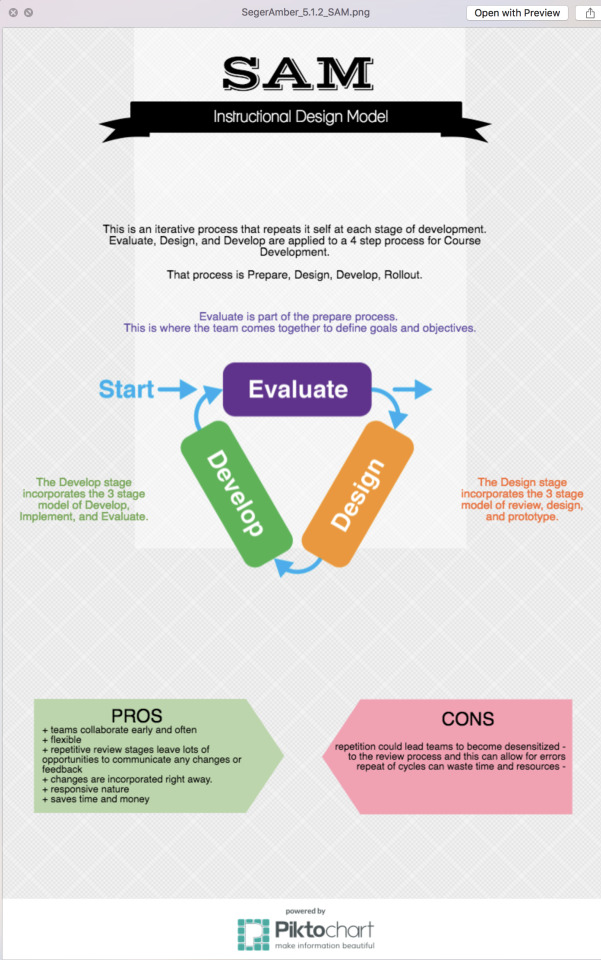
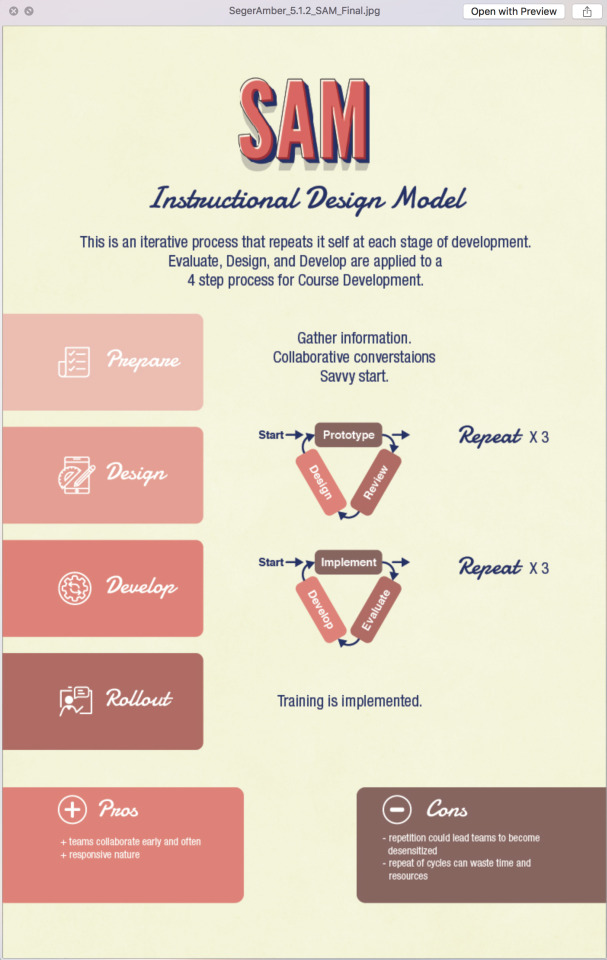
I feel like a huge part of being creative is being receptive to critique. You can’t really design effectively in a void. It’s crucial to have good feedback. Dr. Deason gave me a lot of good input that pushed my posters to a better level.
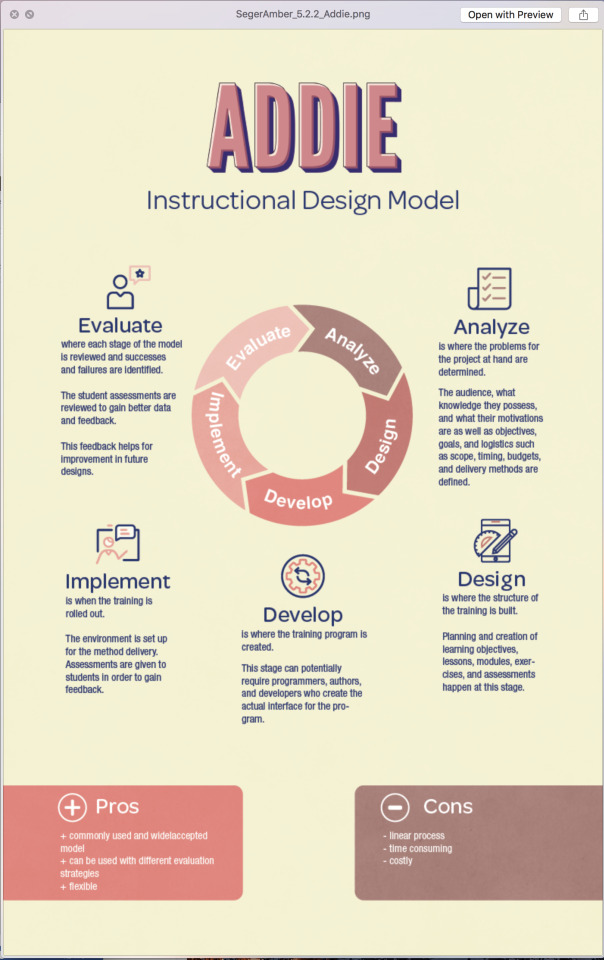
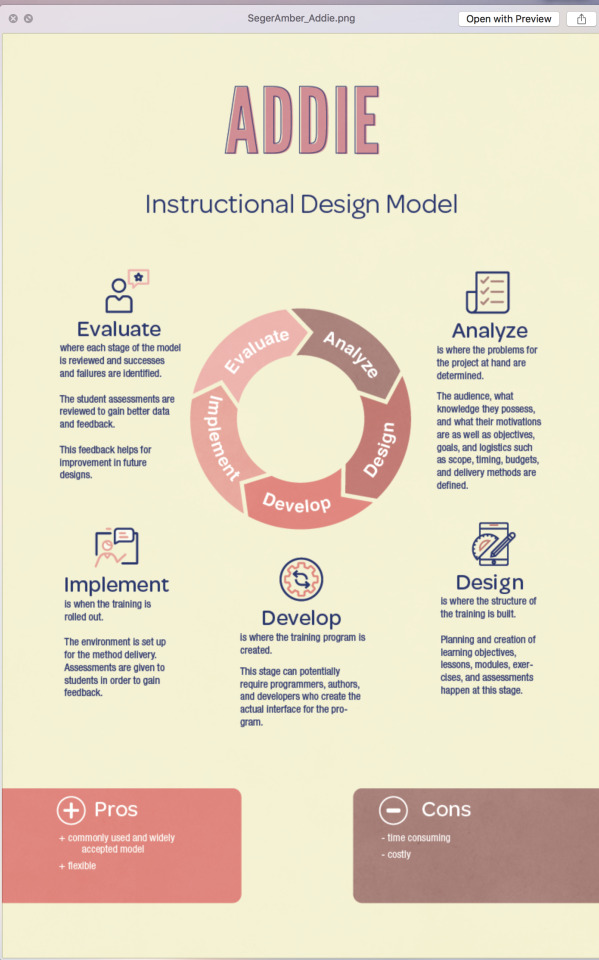
I think challenging yourself to go outside of your comfort zone is another way to spur on creativity. This month we had to create a timeline for Instructional Design and Instructional Media History. I wanted to do something more than the using a web based timeline application, so I attempted to make an interactive pdf. I wanted to see if I could remember how to do it from month 2’s class. Well, I tried. It doesn’t fully work yet. I couldn’t fix it this month, but I plan on getting the rollovers to work so I can use it in my portfolio.
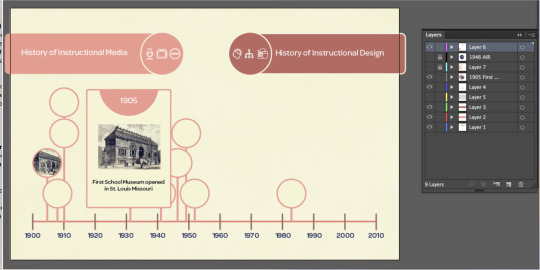
List at least 3 main takeaways from this course and how they may apply to your monthly milestone and long-term goals. How will you use what you have learned in this course to continue to learn and improve your work as an instructional designer?
This month was very enlightening.
My 3 takeaways this month are:
• ADDIE model and the other instructional design models. • Learning theories – especially Gagné’s Nine Events of Instruction • Good instructional design invites inquiry – This is a characteristic I defined with Dr. Deason. I feel like you should always be asking why and how do I make this better, when it comes to designing.
In my live sessions with Dr. Deason, I got to talk a lot about my career path and where I want to go. I even got to show some of the projects I am developing for work. I thought it was cool how much of what I do at work went along with what I was learning this month. I was instinctively following learning theories and design models without knowing they even existed. Now that I have learned what they are, I can use them more effectively!
References
Morrison, G.R., & Tracey, M.W. (2012). Instructional design in business and insutry. In R. A. Reiser, & J. V. Dempsey (Eds.), Trends and issues in instructional design and technology (3rd ed.) (pp. 178-184). Boston, MA: Pearson
1 note
·
View note
Text
Corporate Training and Motivational Development
What does Kolovou discuss and/or demonstrate that you could have applied to improve your presentations during this course?
Kolovou (2014) states, “Introductions and closings are the bookends of your presentation. Be strategic about them and practice them so your energy is strong and your message is clear” (Opening and closing strong, 2:59). I went with a more informal route trying to connect with the audience in our presentation project this month. I could have started with a quote or startling fact, but I wanted to build credibility with the intended audience through what they care about. By mentioning how I care about the world at the beginning, I am letting the audience know that this is going to be about the environment and how we can help take care of it. I also ended by tying it all back to my opening. In this way, I created bookends with my opening and closing statements.
In regards to eye contact Kolovou explains, “For you, as a speaker, eye contact is your most powerful non-verbal. It communicates interest and confidence. It exudes trust and it shows a willingness to connect with your audience” (Strategic eye contact, 2:19). When I first started making drafts of my presentation, it was very difficult to maintain eye contact with the camera. At first this was due to my lack of practice and memorization of my content. Then it was a matter of I kept looking at myself. In order to over come this hurdle, I taped a piece of paper just above my camera as a place for my eyes to focus on. This really helped push my presentation to the next level and I came across as confident and trustworthy.
Figuring out what to do with your hands while speaking is one of the hardest challenges. Kolovou remarks, “Gesture when it's necessary, when your words match your emotions and when your hands can deliver more energy to your audience” (Gestures that engage, 0:34). I found myself often making hand gestures that didn’t add to what I was saying. They would be hovering at my stomach or I would hold my hands together with my fingers laced. When I was recording I would notice this and it was very distracting to me. I had to force myself to be calm and let them do nothing when nothing was happening. Kolovou states, “If your hands rest comfortably by your sides, or on the conference table when you're speaking in front of an audience, you portray a sense of calm and confidence” (Gestures that engage, 0:010). I feel I was able to finally get the hang of this by my last recording session and I can definitely tell a huge difference in confidence level.
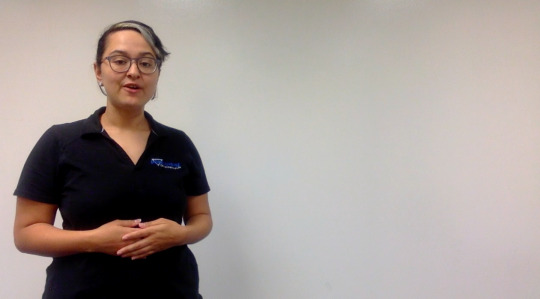
Second recording session. (hand holding)
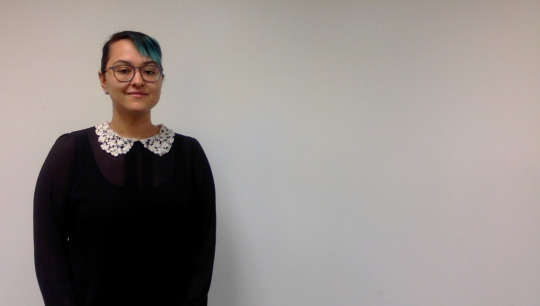
Final recording session. (no more holding hands)
Referring to the readings from your books, what key factors would the graphics in your presentations address in communicating the data/information effectively?
This month we learned a lot of information that reinforced what we learned in our previous classes about cognitive load. I’m going to use this quote again, because it is a good one that I want to remember. Peters (2014) states, “Research shows that people learn processes and principles better from visuals that are in a simplified form. Reducing visual elements will help learners recognize and understand graphics faster and let them focus on the important details” (Simplify explanatory visuals, para. 1). I’ve had this come up in my presentation for work. I got the question of why are simplified graphics better than photographs? It’s because too much detail is distracting. You want viewers to focus on what is important and reduce any other possibility of hindering that information.
There was a term called seductive details that we learned about in Trends and Issues in Instructional Design and Technology by Robert A. Reiser and John V. Dempsey. According to Clark and Mayer (2012), “seductive details consisted of textual information inserted into instructional materials that were intended to arouse interest” (p. 317). Basically, if you are adding graphics that are cool or visually interesting with a lot of detail, you need to consider if they are truly necessary.
Another term we learned is the modality effect. This relates to how it is easier to learn and comprehend information when visuals are paired with audio. We have 2 main sensory channels we receive information through, audio and visual. If we put images and text together, this can overwhelm the visual channel. If you split the information into audio and visual, it becomes easier to process the information. Clark and Mayer (2012) state, “When pictures are explained by words in an audio format, the information is divided between the audio and visual channels of working memory and in that way optimizes the capacity limits of working memory” (p. 317).
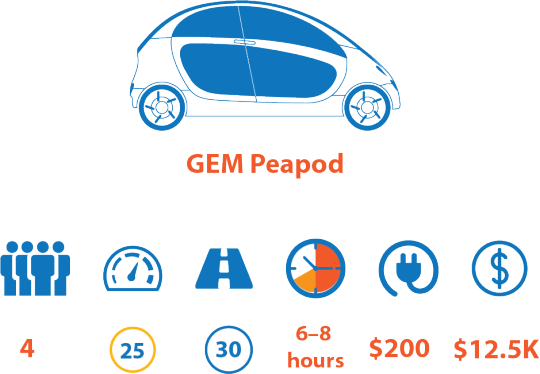
First slide design

2nd Slide Design

Final Slide Design
List at least 3 main takeaways from this course and how they may apply to your long-term goals.
My first main takeaway is practice, practice, practice. I will become a better speaker if I keep doing it often. Kolovou states, “Now delivering presentations is a skill you can master if you practice and prepare with passion and attention to detail” (Practice makes perfect, 0:16). She gives a lot of tips on how to practice as well, such as “Practice your content in 3's. Practice from the intro to the first point. Then take a break. Do something else. Go back to your practice time later” Practice makes perfect, 3:03).
My second takeaway is to stay away from adding seductive details. I do not want to add distractions to my presentations. I want to only present what I want my viewers to remember.
The third takeaway is use audio in conjunction with visuals in order to reduce mental overload. It has been proven that using audio with visuals greatly improves retention of information. However, audio is transient so if I create a presentation it may be good to have key points in text so if viewers want to find the information quickly they can find it.
This was my mental state this month:

Work was grueling this month and it put a lot of stress and emotional strain on me. At one point, I seriously considered putting school on hiatus. There was one night that I sat down at my computer and the idea of working more made me want to vomit. I struggled hard, but I made it.
0 notes
Text
Visual and Verbal Communication in Instructional Design
1) What projected events on your timeline did you achieve this month? What have you learned that you did not anticipate as you created your timeline? How did your attitude, logic and behaviors influence your performance or contribution? What worked? What didn’t?
My goals this month were:
• To be able to write in a tone and manner that is effective for instruction and teaching. • To learn what visual design elements are most effective for presenting information. • To learn how to build course content.
I feel like the class assignments helped me to achieve them to a certain degree. I still need more practice to fully achieve that first bullet.
I also had the side goal of writing and presenting at a child safety conference. The subject was how the brain processes information and how it affects the development of instructional manuals I create for my company’s products. It went really well and you can find the slide and written presentation here: https://drive.google.com/open?id=0B3go25JhZmIFWEZOT1ZEM1o4Tm8
A lot of what I presented goes hand in hand with everything we have been learning up to this point and I felt really proud and confident discussing it with a large group.
Before this class, I did not really know how effective audio can be in learning. I think it’s something I knew inherently by experiencing it naturally without really recognizing and acknowledging it. Last month we talked about cognitive load, working memory, and how we process audio and visuals through different channels. Clark and Mayer (2012) state “When pictures are explained by words in audio format, the information is divided between the audio and the visual channels of working memory and in that way optimizes the capacity limits of working memory” (p. 317). This month that was reinforced more as we read and learned about how to create engaging narration.
The tutorials this month were very fun and informative. I especially enjoyed the infographic tutorial. I didn’t realize how often graphics for data are created in such a way as to skew perception. I created infographics for a newspaper for about a year and I never truly appreciated the data representations I was making or how important they are for visual learning. Peters (2012) states “Some truth will be realized only when numbers are transformed into visuals. Likewise, with massive data sets, implications may be identifiable only through visualization” (Translate large data sets into abstract graphics, para. 2).
A large portion of my current job is creating technical illustrations. Many times people have asked me, why illustrate? Why use line art? Can’t you just use photos? I have always known that line art is better to use but I did not have any evidence to back this up. I was so happy to read about why, that I put it in my presentation for work. Peter (2012) states “Remarkably, people are just as good at recognizing objects in line drawings as they are at recognizing objects in photos, and information conveyed in line drawings is actually more memorable” (Simplify explanatory visuals, para. 4). This is the reason I changed some of the infographic tutorial’s icons as seen below:

I wanted them to be simpler than the chunky graphics that we were to create in the tutorial as shown below:

I can honestly say work completely got in the way this month and it was majorly out of my control. I became very burnt out and exhausted and hit a few points of lethargy. That did not help my contributions at all. I did okay, but I could have done better.
As for what worked and what didn’t, since most of my issues were centered around not having time or energy there wasn’t much I could do. I know what I signed up for when I enrolled in this Master’s degree. It was definitely a struggle this month.
2) Going forward with this yearlong journey, what adjustments could you make to ensure your future success in achieving mastery? What concepts/techniques do you still need to learn about to gain mastery of the material? How do you know? What resources are available to you? What could you have done differently to improve your performance or contribution? How will you approach similar situations in the future? How does this experience inform your professional objectives?
This month was a major challenge for me and it was all centered around time constraints. A lot of major issues came up in my job and I had to travel for work as well. Most of this was out of my control, but somehow I managed to scrape by. It was incredibly difficult though. I bought a day planner to better schedule my time and next month I am going to use it heavily. I have the determination and volition to get through every assignment and work goal, but I need to be more focused and time conscious.
I still feel like a very weak writer and speaker. This comes from a very instilled technical background. I need to learn how to break out of my shell and be more engaging and upbeat. My experience presenting at the conference made me realize how much I need to practice my public speaking. I had a group of colleagues critique my performance and I go a lot of good feedback. It was input such as, go slower, don’t sway back and forth, and make more jokes it relaxes you. I really want to read Talk Like Ted by Carmine Gallo. I have heard great comments about it.
This month, again, because of time constraints, I didn’t feel like I gave it my complete 100% all. I can’t control a lot of that, but I can make the effort to be more proactive and try to do everything as far in advance as I can. Right now I feel like this:

Many times this month, I felt like I had to take a “day off” in order to refresh my brain. I probably didn’t have to, I wanted to. When I feel that desire when I have pressing matters on hand, I have to tell myself power through. I can’t stop. Just go, go, go! This determination and grit I am building will help strengthen my abilities in the future.
References
Clark, R.C., & Mayer, R. E. (2012). Using rich media wisely. In R. A. Reiser, & J. V. Dempsey (Eds.), Trends and issues in instructional design and technology (3rd ed.) (pp. 309-320). Boston, MA: Pearson
Peters, D. (2014). Interface design for learning: Design strategies for learning experiences. San Francisco, CA: New Riders. Retrieved from http://ce.safaribooksonline.com/book/web-design-and-development/9780133365481
1 note
·
View note
Text
Strategies for Learner Engagement
What projected events on your timeline did you achieve?
My goals this month were:
To learn cognitive theories.
To learn what motivates people.
To learn design strategies for learner engagement.
And I achieved all of those through class assignments, reading, and projects.
I still have videos I would like to watch and will do so this week.
They are:
https://www.ted.com/playlists/1/how_does_my_brain_work
http://www.ted.com/talks/dan_pink_on_motivation?language=en
I wasn’t able to do a training course that I wanted to take. It was The Geneva Learning Foundation's open access course called “Become a Digital Scholar.” There was not enough time for it. I did however listen to the audiobook How to Win Friends and Influence People by Dale Carnegie. I am going to listen to Outliers by Malcolm Gladwell next.
What have you learned from this course that you did not anticipate as you created your timeline?
Volition was a term I was not familiar with and it was an awesome concept to understand. I loved finding a research paper about it as well. It motivated me to work on my volition muscle so I can stay focused and finish my goals quickly and successfully. I was also impressed with the the amount of content in Interface Design for Learning by Dorian Peters and that one of my favorite books, 100 Things Every Designer Needs to Know About People by Susan Weinschenk was referenced in it.
I also learned a lot about WW1 artists. That was something I did not expect. I was also happily surprised to get to design an infographic in this course. I thought this course would be focusing on writing and would have a lot more research.
What did you experience in working in a collaborative learning environment?
This course only had me and one other student so it was very personal. Even though we are all in different places, (California, Indiana, and Florida), we all made efforts to reach out and talk with each other. I didn’t feel like I was doing homework to just get through a class.
I very much enjoy helping other people and want others to succeed. So whenever I could I tried to share my advice or give tips. I felt the same was being done for me. It was very enjoyable. I really liked the RISE model for feedback. That was a great guideline to help make effective response posts.
After studying professional examples and some of the theories behind them, and having the opportunity to create an example using some of the technology available to the instructional designer, what adjustments could you make to ensure your future success?
Graphic design is my profession so I felt like I was very strong in making the projects in this class. Although I did everything to fit my own design tastes. In the future I will be working with clients who will have their own visions, so I need to be flexible and keep their design choices in mind while creating. I’m glad my writing was deemed professional. I am very self-conscious about writing because it is something I do not enjoy and have to force myself to do.
Again, 100 Things Every Designer Needs to Know About People, is such a good book and it contains a lot of the same information as Interface Design for Learning. I design every day with the concepts found in 100 Things in mind. In the future I want to keep the following concepts in mind:
Negative and positive reinforcement and punishment
Cognitive Load
Gange’s Nine Events of Instruction
Constructivism
Connectivism
Schema Theory
Start with Usability, Don’t End with It
Leveraging Social Influence for Participation
Balancing Social Polarities
Extrinsic and Intrinsic Motivators
Volition
I have a lot more notes I need to condense down and plan on getting up on my Mastery Journal. I started a notes tag so I can quickly find them on my blog. I also keep every discussion board post (replies and responses) in my class folder so I have them to reference in the future as well.
0 notes
Photo

I am really exhausted.
This month was hard for me mentally and physically. I got super sick with a cold. Work and school combined are causing me to only get about 5 hours of sleep every night. Career wise I am beginning to take on the role of team lead or manager. I have a major project consisting of updating 62 manuals within 7 weeks and I have become the project manager.
However, learning this month has been great. I feel really excited about this new knowledge. The assignments were fun, the reading was interesting, and I had good experiences with my professor and classmate.

Photo.
3 notes
·
View notes
Photo
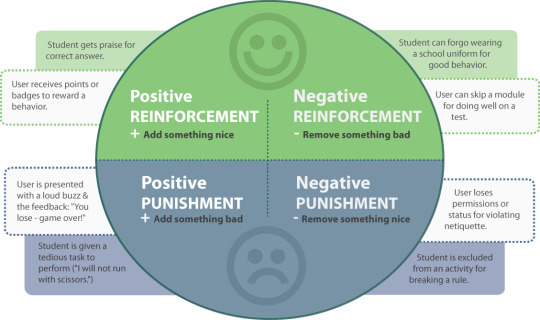
This is something I want to remember that I learned this week. It's from Interface Design for Learning: Design Strategies for Learning Experiences by Dorian Peters.
I think we’ve all heard about Positive and Negative Reinforcement. It falls under the Behaviorist Theory. Think Pavlov’s dog. Anyway, I never really fully understood Positive and Negative Reinforcement until this diagram and also did not know about Positive and Negative Punishment.
Please do not remove the source.
1 note
·
View note
Text
Apparently, next week is a vacation week for Full Sail which I had no idea about. However, I’m going to pretend it isn’t and just power through and get as much homework I can get done as possible.
I took Friday and Tuesday off so I could have a 5 day period of focusing on my life up keep and work ahead in class. I feel like I am going to have a huge advantage in this program because I have a graphic design background.
Our project for two weeks is making an infographic using Illustrator and InDesign. Phfew! I have done it already! I’m 2 weeks ahead as of last night. I worked 7 hours on Friday and about 11-12 hours on Saturday. I’ve even written the summaries for each step of the project.
Reading is reading. I wish the text books where in audio format. I could do so much learning while commuting to work. Instead, I’ve been doing supplemental “reading” when I can. I recently borrowed the audio book Outliers by Malcolm Gladwell from my library and will start listening to on Wednesday.
0 notes
Photo
This branding for ginger ale is so appealing. The green they chose makes me feel warm and fuzzy. It’s probably because it has noise in it as a texture. It feels rustic, natural, and nostalgic like going camping. Picture: hiking on a hot summer day, muggy after raining, right before dusk it starts to cool and a fire is started. This is how I feel when I look at this.

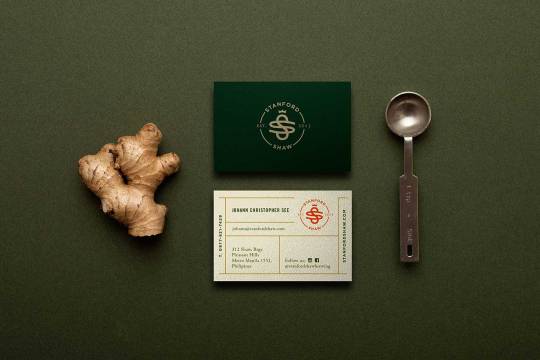



Branding for Stanford Shaw by Análogo
“Stanford Shaw is a young brewing company based in Manila, Philippines. Their old fashioned methods and recipes reminds us of an era when drinks was made by hand: when beverages were brewed from wild roots, freshly plucked fruits, patience and time. Honouring their craft, we look for inspiration in old style monograms and early label design for soda beverages, combining vintage aesthetics with contemporary and clean design.”
Análogo is a design boutique specialized in branding, editorial and graphic design located in Guadalajara Jalisco, México. They offer beautifully crafted and functional solutions through many branding services.
476 notes
·
View notes
Text
First class done! Final grade 97.8 wooooooo!
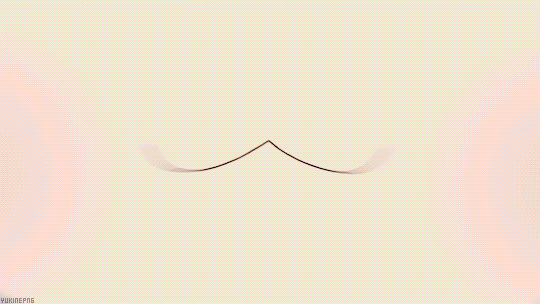
2 notes
·
View notes
Quote
My philosophy: it’s none of my business what people say of me and think of me. I am what I am and I do what I do. I expect nothing and accept everything. And it makes life so much easier.
Anthony Hopkins (via wnq-movies)
This goes along with Greene’s (2012) Conventional Mind. "Under pressure to make a living and conform to society, we force our minds into tighter and tighter grooves” (Greene 176). Break free from it, don’t worry about society so much that it makes life difficult.
Greene, Robert. (2012) Mastery. London, England: Penguin Books.
4K notes
·
View notes
Text
Late
This week was the first week that I was unable to properly budget my time. I was late in submitting my last 2 assignments by 45-50 minutes. How frustrating!
There are a lot of excuses and reasons as to why I was late but honestly I really just let myself down this week. I do not enjoy being late and it upsets me.
I learned my lesson and my goal for next month/class is to get as many of the assignments I can done ahead of time.
0 notes